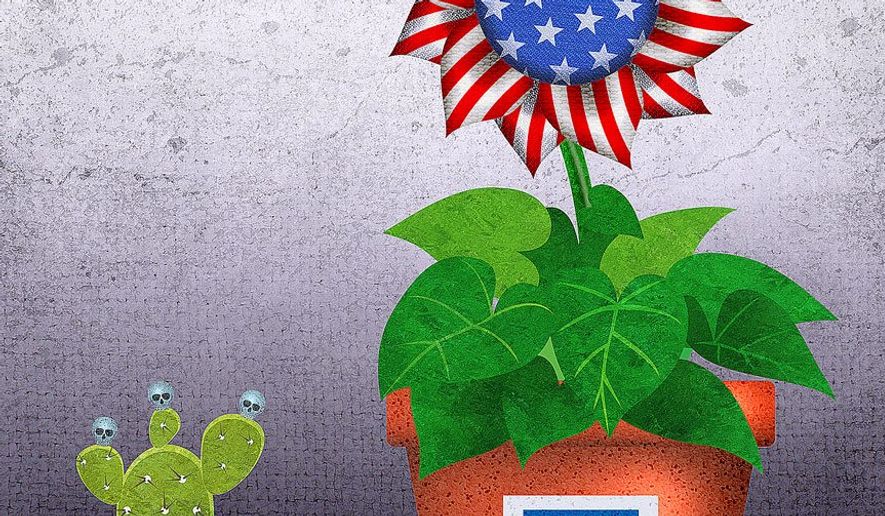OPINION:
Whatever happened to the New Normal? First, Obama Democrats told us that what looked like long-term stagnation under President Obama’s economic policies, with growth stuck at 2 percent on average for his whole eight years in office, was the New Normal that the American people were going to have to get used to, the best we could do now.
That was after the worst recession since the Great Depression, making 10 years of insignificant growth, even though the historical pattern is the worse the recession the stronger the recovery.
Republicans who argued that we could still do much better with 3 percent, even 4 percent growth were derided as out-of-touch, behind-the-times throwbacks.
But as soon as the economy started to peek out into the 3-4 percent range in 2017-18, we were told this was Mr. Obama’s recovery at last. As Steve Forbes suggested, this was like the fired coach of the last place team taking credit for the team’s sudden winning record under the new coach.
President Trump said the suddenly more robust economy starting on his election day was due to the economic policy changes he promised, and then implemented. That included the sharp cuts for both businesses and workers in his tax reform plan, especially slashing America’s highest in the world corporate tax rates to 21 percent, and the pass through rates on mostly smaller businesses effectively by 20 percent.
And it included Mr. Trump’s massive deregulation, eliminating 22 regulations for every new reg adopted. Mr. Trump in particular liberated American energy producers to ultimately lead the world in production of oil, natural gas and coal, not just energy independence, but energy world dominance.
Tax cut and deregulation policies were also central to Ronald Reagan’s historic boom, ultimately lasting a generation, 25 years from late 1982 to late 2007.
Mr. Obama’s economic policies were just the opposite in both respects. He ultimately raised the rates of virtually every major federal tax, except corporate tax rates, already highest in the world, counting state corporate rates.
And Mr. Obama was effectively the Regulation President, especially on energy, where he was well on his way to shutting down the coal industry, along with sharp restrictions on oil production on federal lands and waters, and natural gas in his gunsights next. Only the private sector’s fracking revolution saved oil and gas from Mr. Obama’s regulatory scythe.
You might think that Mr. Obama stubbornly pursuing the opposite, anti-growth policies as Mr. Trump and Mr. Reagan might explain why he got the opposite results.
Indeed, his policies were documented to produce the worst economic recovery from a recession since the Great Depression, in terms of unemployment, economic growth, wage growth, income growth, poverty, even inequality. (Peter Ferrara, “Why the United States Has Suffered the Worst Economic Recovery Since the Great Depression,” Heartland Institute, August, 2016).
Plus recovery from the 11 other recessions since the Great Depression took about two years. Eight would again be the worst by far.
The latest jobs report finds wages rising again after 8-10 years of stagnation, up by 2.9 percent over the last 12 months, the largest since 2009. Pay increases during Mr. Trump’s first year in fact were the highest since the recession ended in 2009.
The National Association for Business Economics reports more companies are now increasing wages and salaries than in the last 18 years. The Institute for Supply Management reports that U.S. manufacturing is expanding at the fastest pace in 13 years. As everyone should know by now, unemployment is the lowest in 17 years, for blacks and Hispanics the lowest ever in American history.
Are these results due to Mr. Obama’s anti-growth economic policies, or to Mr. Trump’s pro-growth changes reversing those policies? With economic growth of 4 percent, the economy doubles every 17 years, eight times after 50 years. With economic growth of 2 percent, the economy doubles every 35 years.
Mr. Obama’s permanent economic stagnation was on track over the long run to fundamentally transform America as he promised, into a Third World country, like Peru. Democrats seem to prefer that, apparently thinking they could then more easily dominate America as a one-party state.
But that deserves exactly zero credit for the economic recovery from the Great Recession, which took Mr. Trump’s historic surprise victory and fundamental policy course correction, to finally show up in 2017-18. The economy will grow 5 percent to 6 percent for a couple of years, to catch up to where it should be on the long-term GDP growth trendline.
• Peter Ferrara is a senior fellow at the Heartland Institute and a senior policy adviser to the National Tax Limitation Foundation.




Please read our comment policy before commenting.